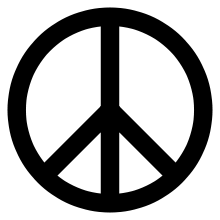Human Be-In

The Human Be-In was an event in San Francisco's Golden Gate Park Polo Fields on January 14, 1967.[1] It was a prelude to San Francisco's Summer of Love, which made the Haight-Ashbury district a symbol of American counterculture and introduced the word "psychedelic" to suburbia.
Origins
The Human Be-In focused the key ideas of the 1960s counterculture: personal empowerment, cultural and political decentralization, communal living, ecological awareness, higher consciousness (with the aid of psychedelic drugs), acceptance of illicit drug use, and radical liberal political consciousness.[2] The hippie movement developed out of disaffected student communities around San Francisco State University, City College and Berkeley and in San Francisco's beat generation poets and jazz hipsters, who also combined a search for intuitive spontaneity with a rejection of "middle-class morality". Allen Ginsberg personified the transition between the beat and hippie generations.
The Human Be-In took its name from a chance remark by the artist Michael Bowen made at the Love Pageant Rally.[3] The playful name combined humanist values with the scores of sit-ins that had been reforming college and university practices and eroding the vestiges of entrenched segregation, starting with the lunch counter sit-ins of 1960 in Greensboro, North Carolina, and Nashville, Tennessee. The first major teach-in had been organized by Students for a Democratic Society at the University of Michigan, 24–25 March 1965.[4]
Event
The Human Be-In was announced on the cover of the fifth issue of the San Francisco Oracle as "A Gathering of the Tribes for a Human Be-In". The occasion was a new California law banning the use of the psychedelic drug LSD that had come into effect on October 6, 1966.[5] The speakers at the rally were all invited by Bowen, the main organizer. They included Timothy Leary in his first San Francisco appearance, who set the tone that afternoon with his famous phrase "Turn on, tune in, drop out" and Richard Alpert (soon to be known as "Ram Dass"), and poets like Allen Ginsberg, who chanted mantras, Gary Snyder and Michael McClure. Other counterculture gurus included comedian Dick Gregory, Lenore Kandel, Lawrence Ferlinghetti, and Jerry Rubin. The Hells Angels, at the peak of their "outlaw" reputation, corralled lost children. Music was provided by a host of local rock bands including Jefferson Airplane, The Grateful Dead, Big Brother and the Holding Company, and Quicksilver Messenger Service, who had been staples of the Fillmore and the Avalon Ballroom since February 1966. "Underground chemist" Owsley Stanley provided massive amounts of his "White Lightning" LSD, specially produced for the event, to the gathered masses.
The national media were agog. No one was able to agree whether 20,000[6] or 30,000 people showed up. Soon every gathering was an "-In" of some kind: Rowan and Martin's Laugh-In comedy television show began airing over NBC just a year later on January 22, 1968. This was followed by the first "Yip-In" (March 21, 1968 at Grand Central Terminal), "Love-In" (April 14, 1968 at Malibu Canyon) and "Bed-In" (March 25, 1969 in Amsterdam).
The Human Be-In was later recalled by poet Allen Cohen (who assisted the artist Bowen in the organizational work,[7][8]) as a necessary meld that brought together philosophically opposed factions of the current San Francisco-based counterculture: on one side, the Berkeley radicals, who were tending toward increased militancy in response to the U.S. government's Vietnam war policies, and, on the other side, the rather non-political Haight-Ashbury hippies, who urged peaceful protest. Their means were drastically different, but they held many of the same goals.
According to Cohen's own account,[9] his friend Bowen provided much of the "organizing energy" for the event, and Bowen's personal connections also strongly influenced its character.[10]
The counterculture that surfaced at the "Human Be-In" encouraged people to "question authority" with regard to civil rights, women's rights, and consumer rights. Underground newspapers and radio stations served as its alternative media.
Influence
The Be-In later spawned a series of Digital Be-Ins.
A leading UK theatre company, Theatre 14167, (also 14167 films) takes its name from the date of the Be-In; the company subsequently produced work by Michael McClure, who read at the event. Additionally, 56 bar in Edinburgh, Scotland, was previously named after the Human Be-In.
See also
References
- ↑ "American Experience Summer of Love". PBS.
- ↑ (Radio Netherlands Worldwide) Neville Powis, "The Human Be-In and the Hippy Revolution" 22 January 2003 Archived April 21, 2006, at the Wayback Machine.
- ↑ "San Francisco Bay Guardian". sfbg.com.
- ↑ New York Times 3/25/65.
- ↑ The connection is made by Powis 2003.
- ↑ "More than 20,000 people showed up". (Powis 2003).
- ↑ The Portable Sixties Reader by Ann Charters published by Penguin Classics, 2003. ISBN 0-14-200194-5, ISBN 978-0-14-200194-3 https://books.google.com/books?id=i05HZYZjTuUC&pg=PA297
- ↑ Brugman, Bruce "Tonight: The Human Be-In 2007", online: http://www.sfbg.com/blogs/bruce/2007/08/the_human_bein_jan_l4_l967_to.html
- ↑ Cohen, Allen "About the Human Be-In" Note: has links to scans of organizational letters that Cohen wrote. This articles is also quoted by Bruce Brugman, online:
- ↑ As Allen Cohen put it: "he was friends with the Beat poets from the North Beach era, and had spent time with Tim Leary at Millbrook. He was an egocentric hustler who Allen Ginsberg had called the most convincing man he had ever known. He could charm the press and turn on a square. He credits himself for inviting Leary and the Beat poets to the Human Be-In, and arranging for it to be a worldwide media event."
Further reading
- Grogan, Emmett (1990). Ringolevio: A Life Played for Keeps. Citadel Press. ISBN 0-8065-1168-0.
External links
- Capsule description.
- Allen Cohen's website, with history from an insider.
- Haight-Ashbury in the 1960s 'Rockument' commentary and sound bites.
- 1967 Berkeley Poster for 'Pow-Wow: A Gathering of the Tribes for a Human Be-In'
